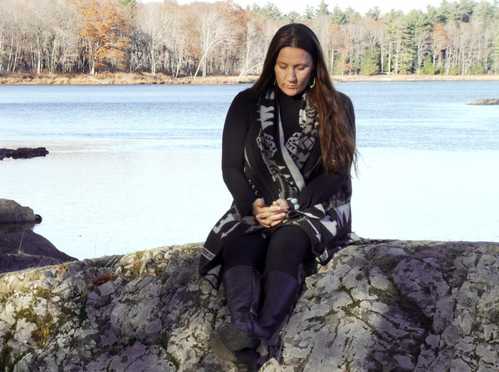Keywords: Wabanaki Nations
Item 6657
Wabanaki trade brooch, ca. 1780
Contributed by: Maine Historical Society Date: circa 1780 Location: Old Town Media: Silver alloy
Item 1475
Penobscot moccasins, Bangor, 1834
Contributed by: Maine Historical Society
Date: circa 1834
Location: Bangor
Media: Leather, wool, cellulosic fiber fabric, silk, glass beads
This record contains 8 images.
Exhibit
Holding up the Sky: Wabanaki people, culture, history, and art
Learn about Native diplomacy and obligation by exploring 13,000 years of Wabanaki residence in Maine through 17th century treaties, historic items, and contemporary artworks—from ash baskets to high fashion. Wabanaki voices contextualize present-day relevance and repercussions of 400 years of shared histories between Wabanakis and settlers to their region.
Exhibit
For one hundred years, Acadia National Park has captured the American imagination and stood as the most recognizable symbol of Maine’s important natural history and identity. This exhibit highlights Maine Memory content relating to Acadia and Mount Desert Island.
Site Page
Mount Desert Island: Shaped by Nature - Wabanaki Today
"Wabanaki Today Wabanaki Today The Indian encampments are no longer part of the cultural or physical makeup of Mount Desert Island; however the…"
Site Page
Mount Desert Island: Shaped by Nature - In the beginning, there were the Wabanaki…
"In the beginning, there were the Wabanaki… Wabanaki encampment, ca. 1000 BCEAbbe Museum Nearly 500 years ago, Wabanakis spotted the first…"
Story
Wabanaki Sovereignty
by Mali Obomsawin and Lokotah Sanborn
Bomazeen Land Trust, renewing and resuming Wabanaki caretaking and stewardship roles
Story
A New Beginning for Wabanaki Land Relationships
by John Banks
Wabanaki leadership in land stewardship
Lesson Plan
Nation to Nation: Treaties and Legislation between the Wabanaki Nations and the State of Maine
Grade Level: 9-12
Content Area: Social Studies
This lesson plan asks high school students to think critically about and look closely at documentation regarding the Nation-to-Nation relationship between the Wabanaki Tribes/Nations and the State of Maine. This lesson asks students to participate in discussions about morality and legislative actions over time. Students will gain experience examining and responding to primary and secondary sources by taking a close look at documents relating to the Maine Indian Claims Settlement Act of 1980 (MICSA) and the issues that preceded and have followed the Act.
Lesson Plan
Grade Level: 3-5, 6-8, 9-12
Content Area: Science & Engineering, Social Studies
This lesson plan will give middle and high school students a broad overview of the ash tree population in North America, the Emerald Ash Borer (EAB) threatening it, and the importance of the ash tree to the Wabanaki people in Maine. Students will look at Wabanaki oral histories as well as the geological/glacial beginnings of the region we now know as Maine for a general understanding of how the ash tree came to be a significant part of Wabanaki cultural history and environmental history in Maine. Students will compare national measures to combat the EAB to the Wabanaki-led Ash Task Force’s approaches in Maine, will discuss the benefits and challenges of biological control of invasive species, the concept of climigration, the concepts of Traditional Ecological Knowledge (TEK) and Indigenous Knowledge (IK) and how research scientists arrive at best practices for aiding the environment.
















